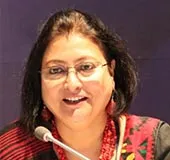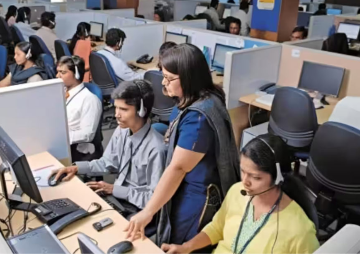
The trade between India and Bangladesh through Integrated Check Post (ICP) at Petrapole, 80 km away from Kolkata the capital of West Bengal recommenced again since 30 April after nearly a month’s gap. Media reports reveal that on the Indian side, 231 trucks are stranded at the border point of Petrapole while another 572 are parked at a place near the check post managed by the local municipal authority. Around 1,300 have registered for loading-unloading operations but are now waiting at different non-registered/private parking lots nearby. It is noteworthy that trade via train movement continues along the Petrapole-Benapole route. Around 1,000 tonnes of onion have been exported from India through Gede-Darshana border point at Nadia.
Initially India responded to the COVID-19 pandemic focusing on what World Health Organisation (WHO) categorises as “imported cases only” — where transmission is limited to international travellers alone. As a result the Indian government took measures to cancel almost all but a small set of visas, largely sealing the country’s borders and restricting all types of passenger movement for foreigners (except few border points) through all Immigration Land Check Posts at Indo-Bangladesh, Indo-Nepal, Indo-Bhutan and Indo-Myanmar border with effect from 15 March 2020 (Vide Ministry of Home Affairs, Government of India , Order No. 25022/12/2017 Imm. dated 14 March 2020). As a consequence, trade between India and Bangladesh came to a standstill at the busiest border point at Petrapole.
Since trade coming to a halt in the third week of March, more than 2,000 trucks carrying essential and perishable items for export had remained stranded near the Petrapole land port.
Trade between these two neighbours started again with both the governments across border agreeing to transfer goods at the zero point of the international border. The central government of India arranged a meeting where the local administration officials also took part and the meeting came up with an acceptable solution by announcing that for the time being, no truck from either side of the border would enter the territory of each other. Following the instruction the cargo was exchanged at the zero point in the presence of customs, Border Security Force (BSF) and police officers, as well as land port and West Bengal state government officials.
Since trade coming to a halt in the third week of March, more than 2,000 trucks carrying essential and perishable items for export had remained stranded near the Petrapole land port. On a normal day, 500-550 trucks cross the border from the Indian side and about 100-150 come from Bangladesh. The pressure from exporters was mounting to resume operations at the ICP. Considering the prevailing situation of the pandemic and with a view to resume cross border trade at Petrapole, it has been decided to allow trans-shipment of EXIM cargo at zero point. As per the decision, the imported goods would be unloaded from Indian trucks at the zero point of the border and stocked on Bangladeshi trucks and vice-versa to avoid spreading of the virus through maintaining maximum social distancing. Normally, Indian trucks are allowed to enter the Bangladeshi side up to the Bangladesh Land Port Authority terminal.
Indian truck drivers were reluctant to enter Bangladesh for the rules set by the West Bengal government that required them to stay in quarantine for 14 days after coming back.
Crossborder trade had been suspended over a month, supposedly due to reservations expressed by the West Bengal government against the backdrop of the pandemic since a large number of clearing agents had been reluctant to undertake the job for fear of contracting the virus. Indian truck drivers were also reluctant to enter Bangladesh for the rules set by the West Bengal government that required them to stay in quarantine for 14 days after coming back.
A glimpse of Petrapole
Trade bottlenecks at the border checkpost were substantially eased with the upgrade of the Land Customs Station to an Integrated Check Post with advanced immigration and customs units along with faster clearance of goods and passengers, specious parking bays, weighbridges, cargo terminals, warehouse facilities, public utility facilities, banks/ATMs, foreign exchange bureaus and cafeterias at Petrapole on 12 February 2016. Apart from Petrapole, another ICP operational between India and Bangladesh is in Agartala at the Agartala-Akhaura border. Apart from these two ICPs, there are 34 Land Customs Stations altogether between the two countries out of which 12 are located in West Bengal in Changrabandha, Fulbari, Radhikapur, Gitaldaha, Ghojadanga, Mahadipur, Hilli, Hemnagar, Gede, Ranaghat, Sindabad and T.T. Shed Khidderpore.
46.5% of India's exports to Bangladesh have been routed by land through trucks while 0.5% through railways and 53% through sea or air routes (2016-17).
Presently, Bangladesh is India's largest trading partner in South Asia, accounting for 37.5% of India's total exports in the region and 20% of India's total imports from the region in 2017. According to EXIM Bank data (2018), Indo-Bangladesh trade has increased by almost two-fold over the past decade to reach USD 6.3 billion in 2017 from USD 3.6 billion in 2008. Over the decade, India's exports to Bangladesh have increased by a CAGR of 6.7% to USD 5.8 billion in 2017 from USD 3.2 billion in 2008, while India's imports from Bangladesh increased by a CAGR of 3.8% from USD 329.8 million in 2008 to USD 459.4 million in 2017. In this export-import circumstance, ICP Petrapole is the largest gateway to Bangladesh contributing nearly 35% of total exports and 58% of imports in 2016-17. Indeed, the trade pattern between India and Bangladesh through land borders differs across states in terms of quantity and variety of product. While only few trade points across the international border are handling the bulk of trade, many of the trade points are not operational yet. Nonetheless, the fact remains that 46.5% of India's exports to Bangladesh have been routed by land through trucks while 0.5% through railways and balance 53% through sea or air routes (2016-17). According to the Central Board of Indirect Taxes and Customs, Marks & Spencer and VIP Industries, the largest import duty payers, are doing business through this border ICP in 2017-18. Along with these the other major companies using Petrapole to import goods include Reliance Retail, Raymond Apparel, Aditya Birla Fashion and Retail, and Puma Sports while among the exporters, companies like Arvind, the manufacturer of Volvo and Eicher trucks, VE Commercial Vehicles, automobile companies such as Ashok Leyland, Hero Motorcorp and Mahindra and Mahindra used this ICP to export goods. Tata Motors appeared as the biggest import duty payer in the last financial year.
As soon as the MHA issued the order (No. 25022/12/2017 Imm dated 14 March 2020) to restrict all passenger movements through all immigration land check posts (as mentioned above) the situation started changing rapidly. As far as the India-Bangladesh border points in West Bengal are concerned the MHA order exempted seven border points, namely Changrabanda, Hili, Ghojadanga, Phulbari, Haridaspur, Gede and Chitpur from this restriction. All the border haats operative between these two neighbours were also declared shut. A report reveals that in this phase of lockdown, Petrapole had witnessed a 10-20% drop in cargo loading. Export cargo arrivals had also slowed down as an impact of the restrictions imposed by the MHA at the outbreak of the pandemic. Later the export and import through this busy gateway stopped for an indefinite period.
Uncertainty still prevails
The MHA issued an order under the directions of the National Disaster Management Authority (NDMA) on 1 May (No: 40 -3/2020-DM-1A) stating that “No State/Union Territories shall stop the movement of cargo for cross land-border under Treaties with neighbouring countries” (Clause 12). The West Bengal government is unhappy with this decision over not being consulted before resuming trade through Indo-Bangla border at Petrapole. It is noteworthy that according to a list released by the West Bengal government on 27 April, four districts, namely Howrah, North 24 Parganas, East Medinipur and Kolkata have been declared as red zones (with 124 <+7> active cases and total number of 18 deaths as of 4 May) in the wake of the COVID-19 outbreak. Incidentally, the zone wise district list prepared by the central government has also identified 24 Parganas as red zones.
It has been stated in the MHA order that all the mentioned restrictions on movements will remain operative for a period of two weeks with effect from 4 May.
The Chief Secretary of the state, Rajiva Sinha, opined that the state would not like any problem to arise in this situation as India shares a good relationship with Dhaka. The challenge remains how to release restrictions in these red zones at this time when the death toll is increasing day by day. The state government has been apprehensive towards maintaining social distancing along with other restrictions of movements mentioned in the MHA order issued on 1 May. It has been stated in the MHA order that all the mentioned restrictions on movements will remain operative for a period of two weeks with effect from 4 May. Against this backdrop, a large number of cleaning workers have been reluctant to undertake their job in fear of the virus. The Cleaning Agent Staff Welfare Association (CASWA) at Petrapole has welcomed the initiative to re-open border trade as the members of the association put forth the request to do so. It seems very difficult to maintain social distancing while transferring goods from one truck to another. Under the circumstances, it has become a real challenge to keep a balance between maintaining social distancing and other suggested restrictions on movements of people and cargo and continuing border trade at Petrapole efficiently at a good pace.
The views expressed above belong to the author(s). ORF research and analyses now available on Telegram! Click here to access our curated content — blogs, longforms and interviews.




 PREV
PREV


